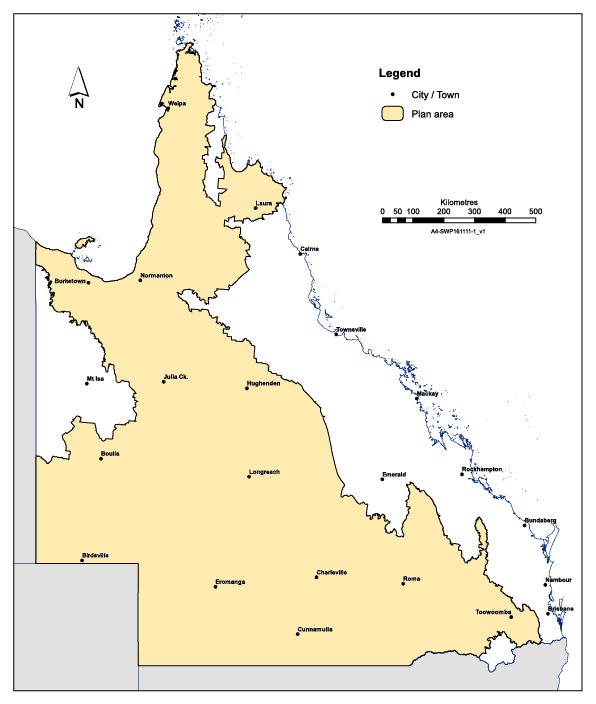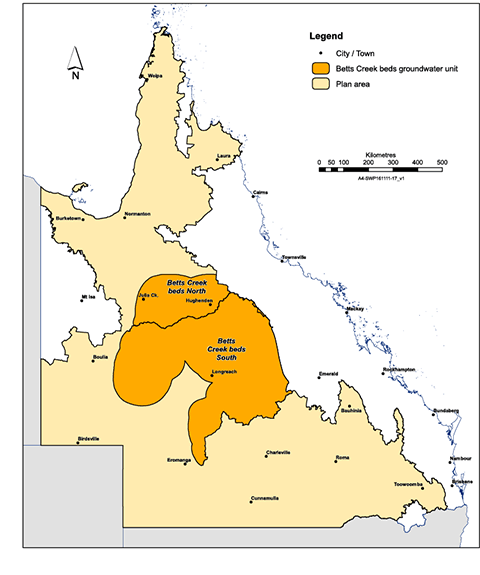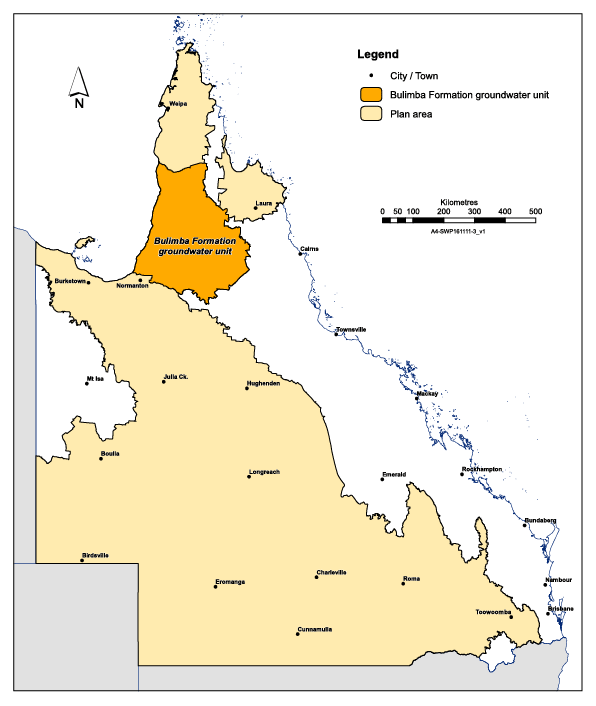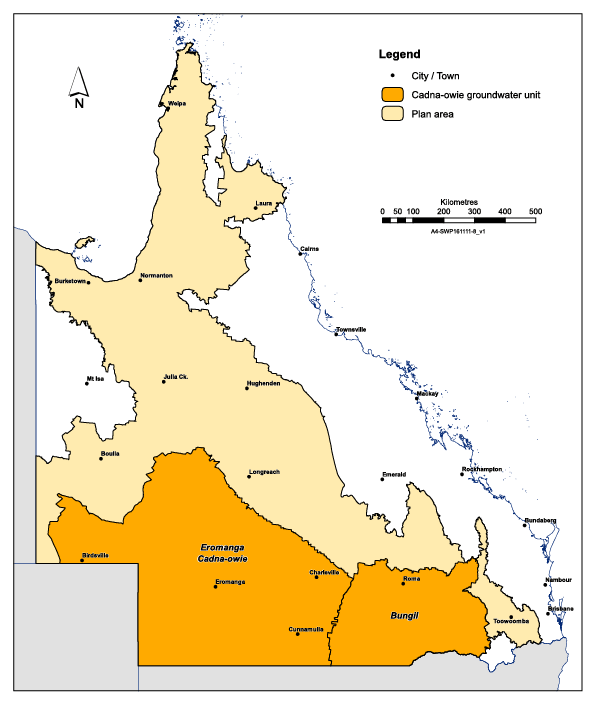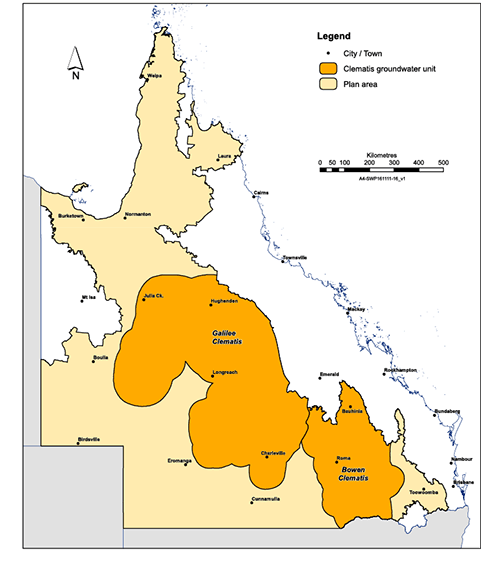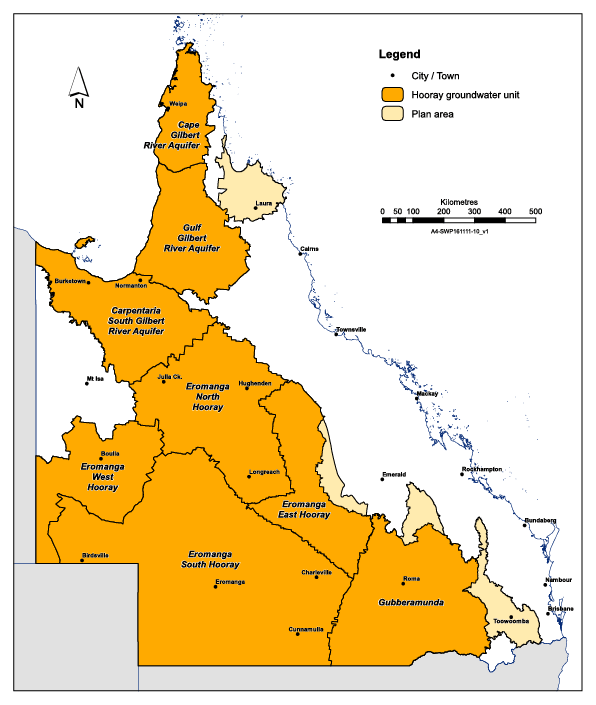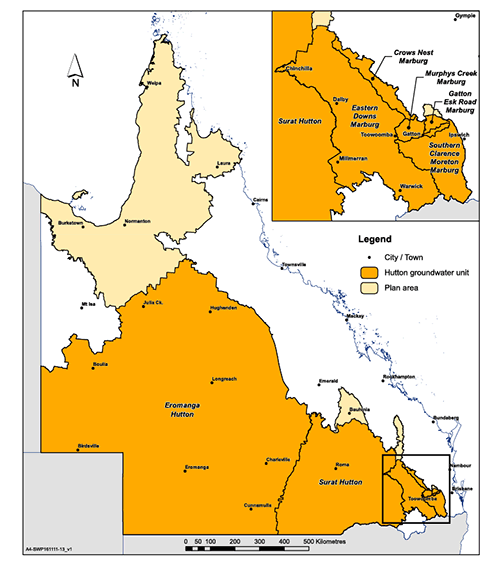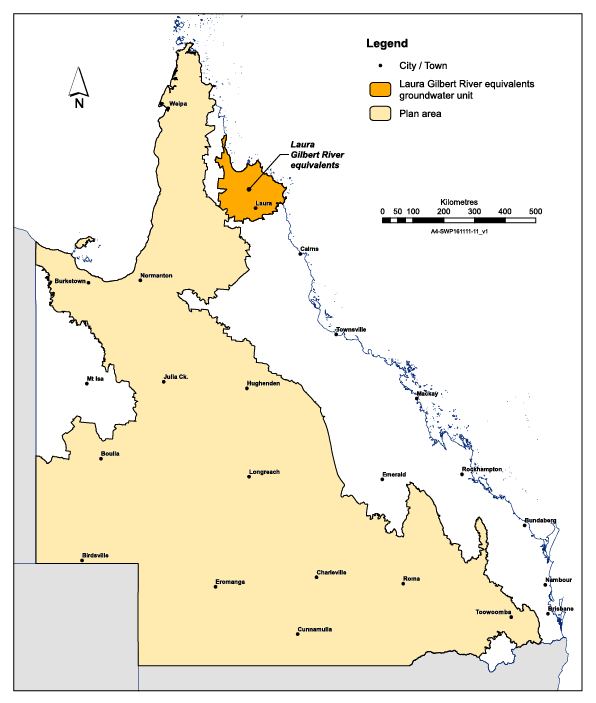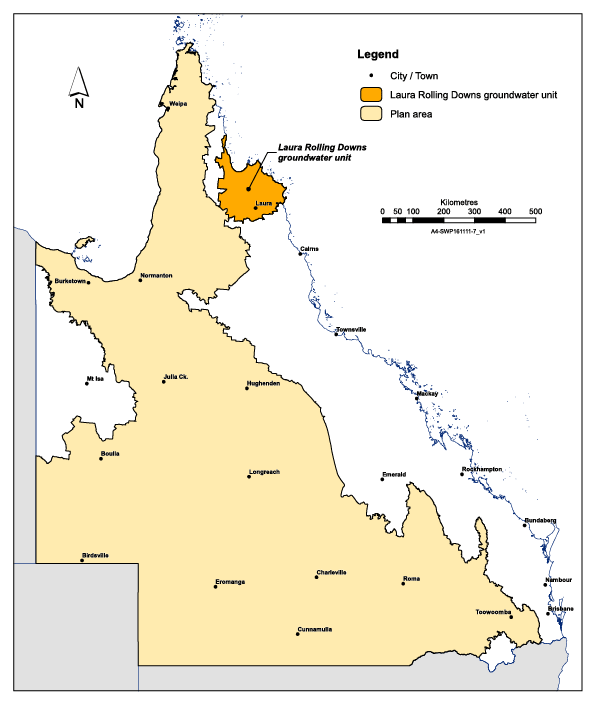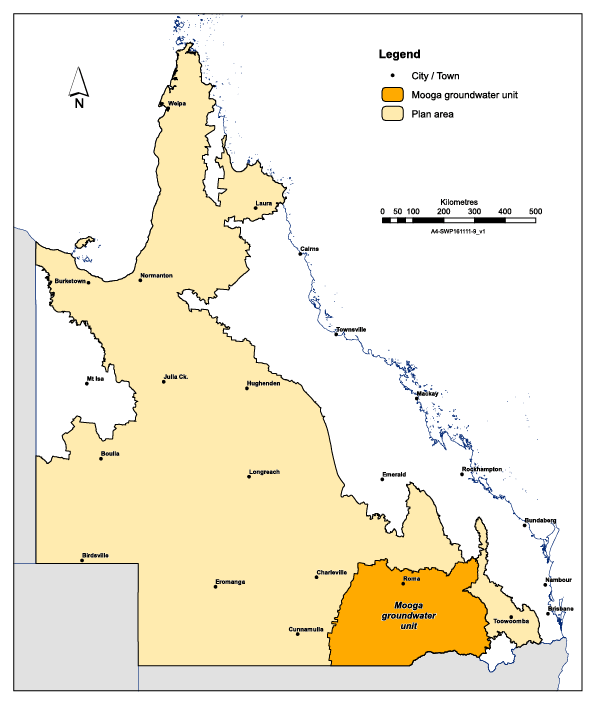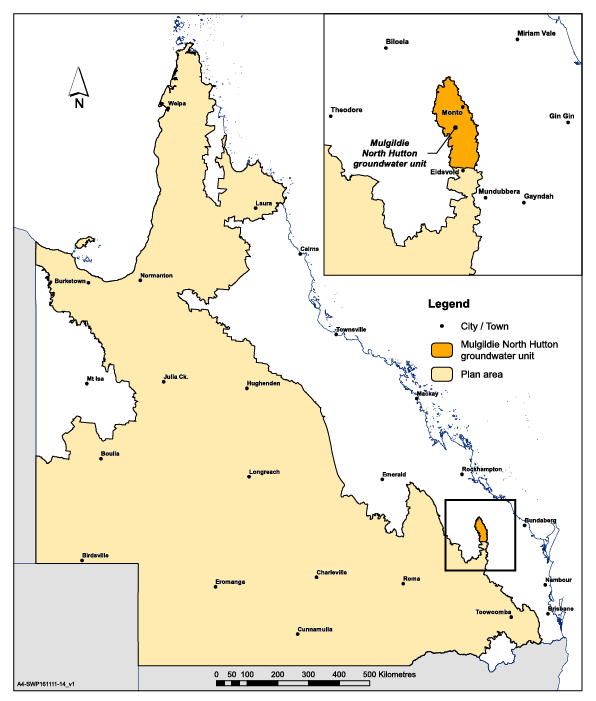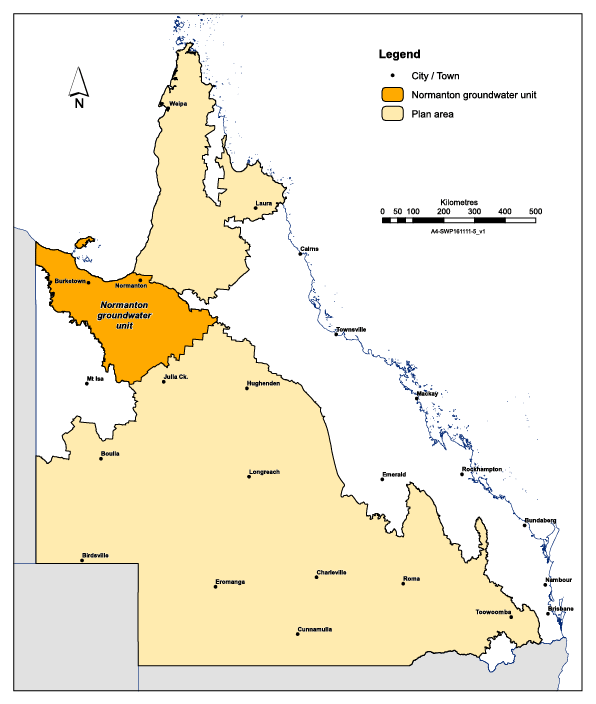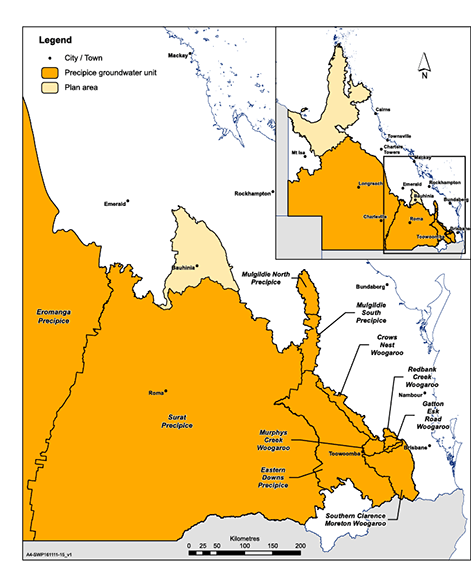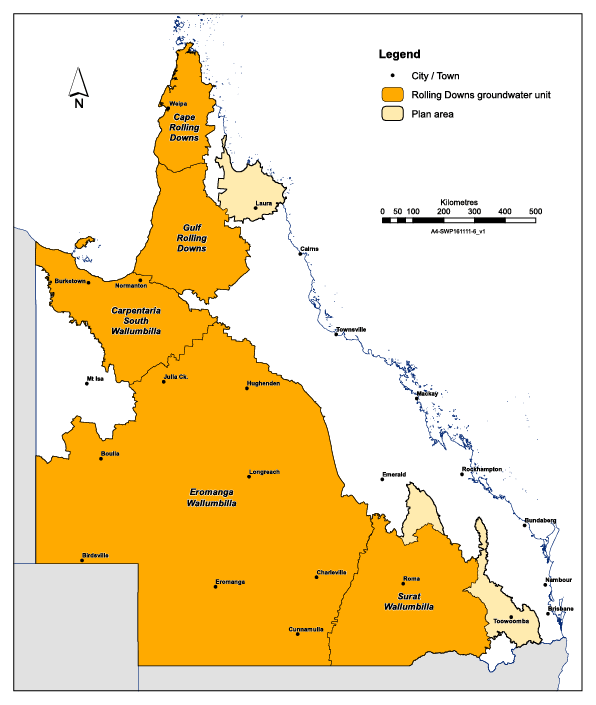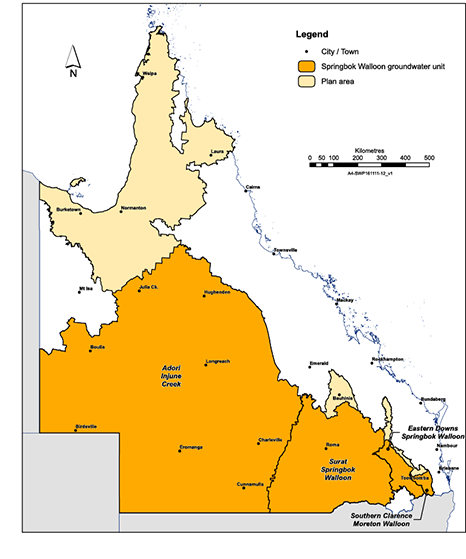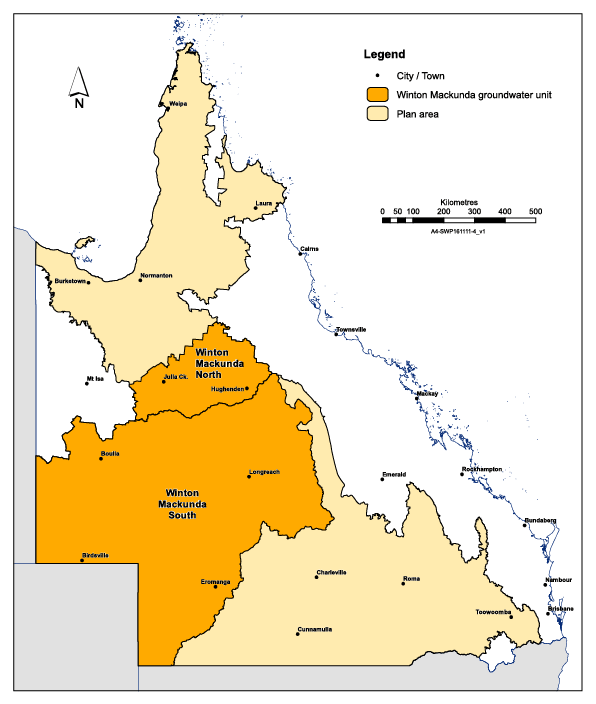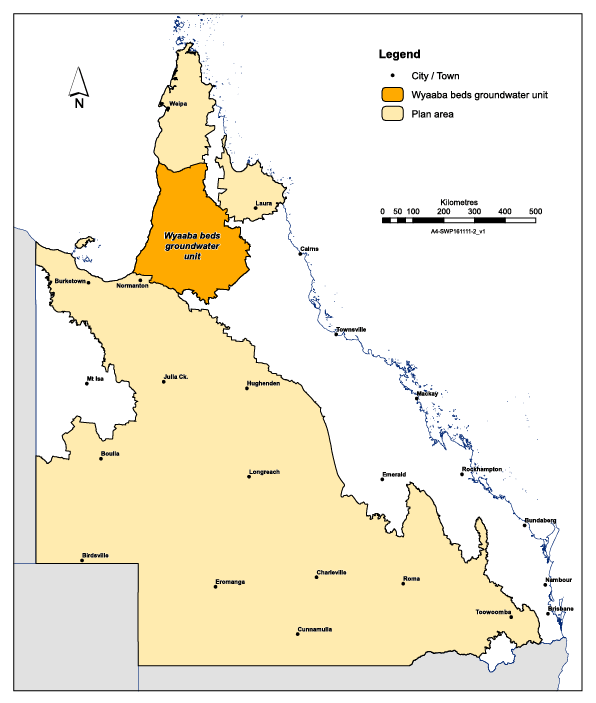This plan may be cited as the Water Plan (Great Artesian Basin and Other Regional Aquifers) 2017.
This plan commences on 2 September 2017.
The purposes of this plan are—(a)to define the availability of water in the plan area; and(b)to provide a framework for sustainably managing water and the taking of water in the plan area; and(c)to identify priorities and mechanisms for dealing with future water requirements; and(d)to provide a framework for reversing, if practicable, the degradation of groundwater-dependent ecosystems.
The dictionary in schedule 6 defines particular words used in this plan.
5Meaning of groundwater-dependent ecosystem
(1)A groundwater-dependent ecosystem is the ecosystem of a spring or watercourse that is maintained by water that flows naturally from a groundwater unit in the plan area.(2)Also, the ecosystem of the Yelarbon Desert is a groundwater-dependent ecosystem.
This plan applies to the following water in or from the groundwater units in the plan area—(a)underground water;(b)water in springs.
This plan applies to the area shown as the plan area on the map in schedule 1.
(1)The plan area is divided into groundwater units.(2)Each part of the plan area shown as a groundwater unit on a map in schedule 2 is a groundwater unit for this plan.(3)A groundwater unit is comprised of the water in and from the geological formations that are—(a)located in the area of the groundwater unit; and(b)stated for the groundwater unit in schedule 3.(4)A reference in this plan to a groundwater unit by name is a reference to the groundwater unit in schedule 2 with that name.
(1)A groundwater unit is divided into groundwater sub-areas if the map for the groundwater unit in schedule 2 shows the groundwater unit is divided into groundwater sub-areas.(2)A groundwater sub-area shown on a map in schedule 2 is a groundwater sub-area for this plan.(3)The area of a groundwater sub-area is shown on the map in schedule 2 for the groundwater unit of which the sub-area is a part.(4)A groundwater sub-area of a groundwater unit is comprised of the water that comprises the groundwater unit that is located in the area of the groundwater sub-area.(5)A reference in this plan to a groundwater sub-area by name is a reference to the groundwater sub-area in schedule 2 with that name.
(1)A water management protocol may declare an area (a zone) in a groundwater unit to be an area in which the following may be limited under this plan or the water management protocol—(a)granting water licences to take water from the unallocated water reserves in the zone;(b)particular dealings with water licences to take water from within the zone.(2)A water management protocol may declare an area under subsection (1) only if the chief executive is satisfied action should be taken in the area—(a)to protect existing authorisations; or(b)to protect natural ecosystems.
The exact location of the boundaries of the plan area, groundwater units, groundwater sub-areas and zones are held in digital electronic form by the department and may be accessed, free of charge, at each office of the department.The location of each office of the department is available on the department’s website.
12Outcomes for management and allocation of water in plan area
Water is to be managed and allocated in a way that—(a)seeks to achieve a sustainable balance between the following outcomes—(i)to protect the flow of water to groundwater-dependent ecosystems that support significant cultural or environmental values;(ii)to protect the continued use of authorisations to take or interfere with water;(iii)to maintain, and if practicable increase, water pressure in aquifers to preserve the supply of water to bores;(iv)to make water available for future development and social and cultural activities that depend on water, including for the aspirations of Aboriginal peoples and Torres Strait Islanders;(v)to encourage the efficient use of water by requiring water bores to have watertight delivery systems or be controlled;(vi)to facilitate the operation of efficient water markets and opportunities for the temporary or permanent movement of water; and(b)recognises the state of aquifers and groundwater-dependent ecosystems has changed because of the taking of, and interfering with, water.
This part states the strategies for achieving the plan outcomes.
14Decision to not increase amount of water taken
(1)The chief executive must not make a decision about the allocation or management of water in the plan area that would increase the volume of water that, on average over the period this plan is in force, may be taken in the plan area.(2)Subsection (1) does not apply to a decision—(a)about a water permit; or(b)about a water licence for taking or interfering with water only for stock or domestic purposes; or(c)to grant a water licence under section 54; or(d)to amend a water licence under section 57; or(e)about reinstating or replacing an expired water licence; or(f)to grant an authority under section 1277 of the Act; orSection 1277 of the Act allows the holder of a relevant petroleum tenure to ask the chief executive to grant an authority to take or interfere with underground water to use in carrying out particular existing activities.(g)about unallocated water made under division 2; or(h)about water sharing rules made under a water management protocol; or(i)required to be made under a water management protocol.
15Decision not to change location from which water may be taken
The chief executive must not make a decision about the allocation or management of water in the plan area that would change the location from which water may be taken in the plan area unless the decision—(a)is otherwise permitted under this plan; or(b)is permitted under the water management protocol.
16Unallocated water held as reserves
Unallocated water is held as a general reserve, State reserve or Aboriginal peoples and Torres Strait Islanders economic reserve and is dealt with under this division.
17Purposes for which unallocated water may be granted
(1)Unallocated water may be granted from the general reserve for any purpose.(2)Unallocated water may be granted from the State reserve for the following purposes—(a)a coordinated project under the State Development and Public Works Organisation Act 1971;(b)a project of regional significance;(c)for water granted to a local government—town water supply purposes;(d)an electricity generation project.(3)A project is a project of regional significance for the plan area if the chief executive considers the project is significant for a region in the plan area, having regard to—(a)the plan outcomes; and(b)the economic or social impact the project will have on the region; and(c)the public interest and the welfare of people in the region; and(d)other matters the chief executive considers relevant.(4)Unallocated water may be granted from the Aboriginal peoples and Torres Strait Islanders economic reserve for the purpose of helping Aboriginal persons or Torres Strait Islanders to achieve their economic aspirations.
18Limitations on granting water from general, State or Aboriginal peoples and Torres Strait Islanders economic reserve
(1)Water may not be granted from an unallocated water reserve in a zone declared under a water management protocol.(2)As far as practicable, water granted from the State reserve and Aboriginal peoples and Torres Strait Islanders economic reserve is to be granted from the groundwater units and groundwater sub-areas—(a)where water from the general reserve is made available under this plan; or(b)where the water is deeper under the ground than the water mentioned in paragraph (a).
19Volume of unallocated water that may be granted from reserves
(1)The total volume of unallocated water that may be granted for water licences from a reserve is stated in schedule 4 as follows—(a)for the general reserve—in table 1;(b)for the State reserve—in table 2;(c)for the Aboriginal peoples and Torres Strait Islanders economic reserve—in table 3.(2)A volume of water stated in a table in schedule 4 is the total combined volume of water that can be granted for water licences from—(a)the reserve to which the table relates; and(b)all of the groundwater units and groundwater sub-areas stated opposite the volume of water in the table.
20Water granted from State reserve
Water granted from the State reserve for a project mentioned in section 17(2)(a), (b) or (d) is granted only for the life of the project and returns to the State when the project ends.
21Water from cancelled, surrendered or expired licences
When a water licence is cancelled or surrendered or has expired, the volumetric limit for the water licence may become unallocated water.
22Processes for releasing unallocated water
The processes for releasing unallocated water in the plan area are the processes stated in the Water Regulation 2016, part 2, division 2, subdivision 2.
23Matters chief executive must consider
(1)In dealing with unallocated water, the chief executive must consider—(a)the need for, and efficiency of, current and proposed uses of water, including—(i)the extent to which water is currently being taken under water licences and statutory authorisations to take or interfere with water in the plan area; and(ii)emerging requirements in the plan area for additional water and the likely timeframe in which the additional water will be required; and(iii)water savings that may be made by improving the efficiency with which water is taken and used, including, for example, installing a watertight delivery system for a water bore; and(b)the availability of an alternative water supply for the purpose for which water is required; and(c)the impact the proposed taking of, or interfering with, water may have on—(i)the flow of water to groundwater-dependent ecosystems; and(ii)groundwater pressure and levels; and(iii)on existing water licences and statutory authorisations to take or interfere with water.(2)Subsection (1) does not limit the matters the chief executive may consider.
24Granting unallocated water from a reserve
(1)The chief executive may require an applicant for a water licence to take water from an unallocated water reserve to—(a)investigate the likely impact the proposed taking of water may have on the following—(i)the flow of water to groundwater-dependent ecosystems;(ii)groundwater pressure and levels;(iii)existing water licences and statutory authorisations to take or interfere with water; and(b)carry out—(i)studies relating to the relevant groundwater-dependent ecosystems and the groundwater units connected to the ecosystems; or(ii)a hydrogeological assessment; and(c)include the results of the investigation, studies or assessment with the application.(2)If the chief executive grants a water licence for water from an unallocated water reserve, the chief executive may impose conditions on the licence requiring the holder of the licence to—(a)provide and maintain access to alternative water supplies for existing water users who would be significantly adversely affected by the granting of the licence; and(b)carry out and report on a stated monitoring program.(3)However, if granting the water licence will result in the drawdown at a relevant location being more than the maximum drawdown, the chief executive must impose the conditions stated in subsection (2) on the licence.(4)In this section—existing water user means a person authorised under a water licence or statutory authorisation to take or interfere with water.relevant location means a location from which an existing water user is authorised to take water.
25Limitations on taking or interfering with water—Act, s 101
For section 101(1) of the Act, a person may take or interfere with water in the plan area under that section only if the person is authorised to take or interfere with the water under—(a)a water licence, water permit or seasonal water assignment notice; or(b)section 26, 27 or 28.
26Taking water for stock or domestic purposes
(1)A person may take—(a)water from a groundwater unit or groundwater sub-area mentioned in subsection (3) for stock purposes; and(b)water in the plan area for domestic purposes.(2)However, water may be taken under subsection (1) only if—(a)the water is taken using a water bore that has a water tight delivery system; and(b)the taking will result in the cumulative drawdown for a groundwater-dependent ecosystem being less than 0.4m; and(c)the taking will result in the drawdown at a location from which another person is authorised to take water under a water licence or particular authorisation being less than the maximum drawdown.A water management protocol must include ways for the chief executive to—1estimate the cumulative drawdown, or otherwise be satisfied the cumulative drawdown, for a groundwater-dependent ecosystem as a result of a taking of water is less than 0.4m,; and2estimate the drawdown at a location, or otherwise be satisfied the drawdown at a location, as a result of a taking of water is less than the maximum drawdown.See section 58(2).(3)For subsection (1)(a)—(a)the groundwater units are the following—•Betts Creek beds•Mulgildie North Hutton•Normanton•Winton Mackunda; and(b)the groundwater sub-areas are the following—•Cape Rolling Downs•Crows Nest Marburg•Crows Nest Woogaroo•Eastern Downs Marburg•Eastern Downs Precipice•Eastern Downs Springbok Walloon•Gatton Esk Road Marburg•Gatton Esk Road Woogaroo•Mulgildie North Precipice•Mulgildie South Precipice•Murphys Creek Marburg•Murphys Creek Woogaroo•Redbank Creek Woogaroo•Southern Clarence Moreton Marburg•Southern Clarence Moreton Walloon•Southern Clarence Moreton Woogaroo.
27Taking or interfering with water to monitor aquifer
A person may take or interfere with water in the plan area using a water bore for the purpose of monitoring the water in an aquifer if—(a)the maximum volume of water taken from the bore is 2ML during a water year; and(b)the bore is controlled.
28Other taking or interfering with water
(1)A person may take or interfere with water in the plan area—(a)for a project for the economic or social benefit of Aboriginal peoples or Torres Strait Islanders; or(b)for a prescribed activity under the Water Regulation 2016.(2)However, water may only be taken from a water bore for the purposes or activities mentioned in subsection (1) if—(a)the maximum volume of water taken from the bore is 2ML during a water year; and(b)the bore is controlled; and(c)the taking will result in the cumulative drawdown for a groundwater-dependent ecosystem being less than 0.4m; and(d)the taking will result in the drawdown at a location from which another person is authorised to take water under a water licence or particular authorisation being less than the maximum drawdown.A water management protocol must include ways for the chief executive to—1estimate the cumulative drawdown, or otherwise be satisfied the cumulative drawdown, for a groundwater-dependent ecosystem as a result of a taking of water is less than 0.4m,; and2estimate the drawdown at a location, or otherwise be satisfied the drawdown at a location, as a result of a taking of water is less than the maximum drawdown.See section 58(2).
29Meaning of controlled and watertight delivery system for a water bore
(1)A water bore is controlled if it is—(a)a subartesian bore; or(b)an artesian bore that has permanent headworks controlling the flow of water from the bore; or(c)an artesian bore and water from the bore no longer flows naturally to the surface.(2)A water bore has a watertight delivery system if—(a)the bore is controlled; and(b)water taken from the bore is distributed by a pipeline to a trough that contains the water; and(c)the following are maintained in a way that minimises the loss of water—(i)the bore, pipeline and trough; and(ii)any cooling pond or storage tank mentioned in subsection (3).(3)For subsection (2)(b), water taken from the water bore may be held temporarily in either of the following before being distributed to a trough—(a)a cooling pond for the purpose of cooling the water to a temperature that is suitable to be distributed for its intended use;(b)a storage tank.
This subdivision applies to the taking of water for stock or domestic purposes using a water bore.
31Requirement for water tight delivery system to take water
(1)A person must not take water using a water bore that does not have a watertight delivery system unless the person holds a water licence allowing the person to take water using a bore that does not have a watertight delivery system.(2)The bore owner of a water bore drilled after the commencement must install a watertight delivery system for the bore.(3)Subsection (4) applies if a water bore is drilled after the commencement to replace another bore that—(a)existed before the commencement; and(b)did not have a watertight delivery system.(4)Subsection (2) does not apply and the bore owner need only ensure the water bore is a controlled bore.
32Notice that water bore is not controlled or does not distribute water by pipeline
(1)This section applies if the chief executive becomes aware that a water bore from which water may be taken under a water licence—(a)is not controlled, whether or not the bore was previously controlled; or(b)does not distribute water taken from the bore by a pipeline to a trough that contains the water.(2)The chief executive must, as soon as practicable, give the licensee a notice stating—(a)the matter stated in subsection (1) of which the chief executive has become aware; and(b)that the licence must be amended under section 33 to impose the conditions mentioned in that section.
33Water licence to require installation of watertight delivery system for water bore
(1)This section applies if—(a)a water bore from which water may be taken under a water licence did not have a watertight delivery system on the commencement; or(b)the chief executive gives the holder of a water licence a notice under section 32.(2)The water licence must, unless it has been amended under part 5, division 2, be amended to include a condition requiring a watertight delivery system to be installed for the water bore by—(a)if the water bore did not have a watertight delivery system on the commencement—2 September 2027; or(b)10 years after the day the chief executive gives the licensee a notice under section 32(2).(3)Also, the water licence must, unless it has been amended under section 50, be amended to include a condition requiring the licensee to give the chief executive written notice of when a watertight delivery system has been installed for the water bore.
34Licensees obligations within first year
(1)If a condition of a water licence requires a watertight delivery system to be installed for a water bore, the licensee must, before the end of the first year, give the chief executive—(a)if the licensee intends to install the watertight delivery system during the first year—a notice stating when the licensee intends to install the system; or(b)otherwise—a bore management statement for the water bore.(2)The notice given under subsection (1)(a) must also be given at least 1 month before the licensee finishes installing the watertight delivery system.(3)In this section—bore management statement, for a water bore, means a notice stating—(a)how the licensee intends to install a watertight delivery system for the bore; and(b)how the licensee intends to complete the installation by the day required under the licence.first year, in relation to a condition of a water licence mentioned in subsection (1), means the period of 1 year starting on the day the chief executive gives the licensee a notice—(a)if the water bore had a watertight delivery system on the commencement but no longer has a watertight delivery system—under section 32(2); or(b)otherwise—stating that the water licence has been amended under section 33(2) to include the condition.
35Chief executive must consider whether time for installation is reasonable
(1)As soon as practicable after 2 September 2022, the chief executive must decide whether a requirement, under a condition of water licences, for licensees to install a watertight delivery system for water bores by 2 September 2027 is reasonable.(2)In making the decision, the chief executive may consider—(a)whether a program of financial assistance to install watertight delivery systems for water bores is available to licensees; and(b)whether climatic or economic conditions since the commencement are likely to have affected the ability of licensees to install water tight delivery systems for bores; and(c)other matters the chief executive considers relevant.(3)If the chief executive decides the requirement is not reasonable, the chief executive may decide, by a written notice published on the department’s website, a later day (the new installation day) by which licensees are to be required to install a watertight delivery system for a water bore.(4)If a water licence states a day after 2 September 2027 by which a watertight delivery system is to be installed for a water bore and the day is before the new installation day, the watertight delivery system is required to be installed by the new installation day.(5)The chief executive may amend a water licence to reflect the new installation day for a water bore.
(1)This subdivision applies if a person holds a water licence to take water using a water bore for a purpose other than stock or domestic purposes.(2)Section 37 also applies if a person holds a water permit to take water using a water bore for a purpose other than stock or domestic purposes.
37Water bore must be controlled and minimise water loss
The person must not take water under the water licence or water permit using the water bore unless—(a)the bore is—(i)controlled; and(ii)maintained in a way that minimises the loss of water; or(b)the water licence or water permit allows water to be taken using a bore that is not controlled.
38Notice that water bore is not controlled
(1)This section applies if the chief executive becomes aware that a water bore that was controlled is no longer controlled because the groundwater pressure has changed.(2)The chief executive must, as soon as practicable, give the holder of the water licence a notice stating that—(a)the bore is not controlled; and(b)the licence must be amended in the way stated in subsection (3).(3)The water licence must be amended to—(a)allow the holder to take water using the bore that is not controlled; and(b)include conditions requiring the holder—(i)to ensure the bore is controlled within 10 years after the holder was given the notice under subsection (2); and(ii)to give the chief executive written notice about when the water bore is controlled.
39Holder’s obligations within first year
(1)If a condition of a water licence requires a water bore to be controlled, the holder must, before the end of the first year, give the chief executive—(a)if the holder of the licence intends to comply with the condition during the first year—a notice stating when the holder intends to comply with the condition; or(b)otherwise—a bore management statement for the water bore.(2)The notice given under subsection (1)(a) must also be given at least 1 month before the holder finishes complying with the condition.(3)In this section—bore management statement, for a water bore, means a notice stating how the holder of a water licence intends, by the day required under the licence, to control the bore and maintain it in a way that minimises the loss of water.first year means the period of 1 year starting on the day the chief executive gives the licensee a notice under section 38(2).
Division 5 Ensuring water licence decisions protect flows of water to groundwater-dependent ecosystems, existing licences and particular authorisations
(1)This division applies to a decision to—(a)grant a water licence to take water from an unallocated water reserve; or(b)grant a water licence to take water for stock or domestic purposes; or(c)grant a seasonal water assignment for a water licence; or(d)amend or relocate a water licence.(2)However, this division does not apply to a decision to grant a water licence to a person under section 54 or 68.
41Protecting the flow of water to groundwater-dependent ecosystems
The chief executive must not make the decision unless the cumulative drawdown for the groundwater-dependent ecosystem, after making the decision, would be less than 0.4m.A water management protocol must include ways for the chief executive to estimate the cumulative drawdown, or otherwise be satisfied the cumulative drawdown, for a groundwater-dependent ecosystem after making a particular decision is less than 0.4m. See section 58(2)(a).
42Protecting existing water licences and particular authorisations to take water
The chief executive must not make the decision unless the drawdown at a location from which water may be taken under an existing water licence or particular authorisation, after making the decision, would be less than the maximum drawdown.A water management protocol must include ways for the chief executive to estimate the drawdown at a location, or otherwise be satisfied the drawdown at a location, after making a particular decision is less than the maximum drawdown. See section 58(2)(b).
43Chief executive may require investigation, studies or hydrogeological assessment
The chief executive may require the applicant for the decision to—(a)investigate the likely impact the proposed taking of water may have on the following—(i)the flow of water to groundwater-dependent ecosystems;(ii)groundwater pressure and levels;(iii)existing water licences and statutory authorisations to take or interfere with water; and(b)carry out—(i)studies relating to the relevant groundwater-dependent ecosystems and the groundwater units connected to the ecosystems; or(ii)a hydrogeological assessment.
44Water licences must state volumetric limit
(1)A water licence to take water in the plan area must state a volumetric limit for the licence.(2)For section 133(2) of the Act—(a)a water licence that does not state a volumetric limit is not inconsistent with this plan if the licence is for taking or interfering with water only for—(i)stock or domestic purposes; or(ii)cultural or environmental purposes; and(b)the time within which the chief executive must amend a water licence that is inconsistent with this section is the period this plan is in force.
45Deciding volumetric limit for a water licence
(1)In deciding the volumetric limit for a water licence, the chief executive must consider—(a)the terms and conditions of the licence; and(b)the efficiency of the use of water taken under the licence; and(c)the impact the taking is having on—(i)the flow of water to groundwater-dependent ecosystems; and(ii)groundwater pressure and levels; and(iii)existing water licences and statutory authorisations to take or interfere with water; and(d)the sustainable management of water in the groundwater unit or groundwater sub-area to which the licence relates; and(e)the availability of an alternative water supply for the purpose for which water is being taken under the licence; and(f)if the licence states a condition that water taken under the licence is for supplementary irrigation—the proportion of water taken under the licence and the reliability and proportion of water obtained from other water sources on 31 March 2006.(2)Also, in deciding the volumetric limit for a water licence, the chief executive may consider the following matters—(a)for a purpose for which water is taken under the licence—(i)the works used for the purpose; or(ii)the water-taking capacity of the works; or(iii)the area being supplied using the works;(b)the history of water use under the licence;(c)another matter the chief executive considers appropriate.
This part does not limit the conditions the chief executive may otherwise impose on a water licence.
47Consultation with other States
(1)This section applies if—(a)the chief executive proposes to make a decision about granting or amending a water licence; and(b)the decision could have an adverse impact on groundwater pressure and levels at the border of Queensland and another State.(2)The chief executive must consult with, and consider any information provided by, the other State before making the decision.
This division applies if—(a)a water licence includes a condition that requires a watertight delivery system to be installed for a water bore; and(b)the licensee applies to amend the licence to—(i)change or remove the condition; and(ii)allow water to be taken from the bore without a watertight delivery system for the purpose of sustaining, or contributing to sustaining, culturally or environmentally significant values that existed on the commencement.
(1)The licensee’s application to amend the licence must—(a)identify the culturally or environmentally significant values; and(b)state the volume of water required to sustain the values; and(c)state the way the licensee intends to deliver water to sustain the values and minimise the volume of water wasted; and(d)include any evidence relied on to support a matter stated in paragraph (a) to (c).(2)This section applies in addition to the requirements for making an application stated in section 122(1) of the Act.
50Chief executive may amend water licence
(1)This section applies if the chief executive is satisfied—(a)water taken from the water bore without a watertight delivery system will sustain, or contribute to sustaining, culturally or environmentally significant values; and(b)the culturally or environmentally significant values existed on the commencement.(2)The chief executive may amend the water licence to—(a)change or remove the condition that requires a watertight delivery system to be installed for the bore; and(b)allow water to be taken from the bore without a watertight delivery system.(3)If the chief executive amends the water licence under subsection (2), the chief executive must also—(a)ensure the conditions of the licence identify, and are consistent with, the culturally or environmentally significant values to be sustained by water that flows from the water bore; and(b)amend the water licence to state that water may be taken for cultural purposes or environmental purposes while the culturally or environmentally significant values exist.(4)The chief executive may also impose conditions that—(a)limit the rate at which water may be taken from the water bore; and(b)restrict the flow of water to particular locations where the culturally or environmentally significant values exist.
bore works, for a water bore, means—(a)works to install a watertight delivery system for the bore; or(b)permanent headworks to control the flow of water from the bore; or(c)a pipeline to distribute water taken from the bore.required bore works see section 52(b).volume of saved water, for a water bore, means—(a)the volume of water the chief executive estimates was taken from the bore during a water year, after the commencement but before particular bore works are installed for the bore; less(b)the volume of water the chief executive estimates will be taken from the bore during a water year after the particular bore works are installed for the bore.
This division applies in relation to the licensee of a water licence to take water using a water bore if, after the commencement, the licensee—(a)is allowed, under the licence, to take water using a water bore that does not have a watertight delivery system; and(b)is required, under the licence, to install stated bore works for the bore (the required bore works); and(c)installs, or intends to install, the required bore works by the day required under the licence; and(d)has not received, or does not intend to receive, government funding for installing the required bore works.
(1)The licensee may apply for a water licence to take 30% or more of the volume of saved water for the water bore.(2)The application must be—(a)made to the chief executive in the approved form; and(b)accompanied by—(i)the fee prescribed by regulation; and(ii)information to help the chief executive estimate the volume of saved water for the water bore; and(iii)if the licensee has installed the required bore works by the day required under the licence—evidence of that fact; and(iv)if the licensee intends to install the required bore works for the bore by the day required under the licence—information about how the licensee intends to install the bore works by that day and fund the installation; and(v)if the application is for more than 30% of the volume of water saved for the bore—any evidence relied on to support a matter stated in section 54(2).
54Granting water licence to take percentage of volume of saved water
(1)The chief executive may grant the water licence to take, for any purpose, the following percentage (the granted percentage) of the volume of saved water for the water bore because of the installation of the required bore works—(a)30%; or(b)a greater percentage decided by the chief executive.(2)In deciding whether to grant the water licence to take more than 30% of the volume of saved water for the water bore, the chief executive must be satisfied the greater percentage—(a)provides an incentive to the licensee, or another person, to install the required bore works for the water bore; and(b)promotes, and does not negatively affect, the plan outcomes.(3)Subject to section 55(2), the volumetric limit to be stated for the water licence is the granted percentage of the volume of water saved for the water bore because of the installation of the required bore works.(4)In granting the water licence, the chief executive must impose a condition on the licence that requires the licensee to install a measuring device to measure the volume of water taken from the water bore.(5)Subsection (4) does not apply if the water licence, when granted, would be a metered entitlement.
55Effect of water licence if granted before watertight delivery system installed
(1)This section applies if the chief executive decides to grant the water licence under section 54 before the required bore works are installed.(2)The volumetric limit to be stated for the water licence is 0ML.(3)The chief executive must also impose the following conditions on the licence—(a)a condition that the volumetric limit to be granted after the required bore works are installed is the granted percentage of the volume of saved water for the water bore;(b)a condition that the water licence is to be cancelled if—(i)the required bore works are not installed for the water bore by the day required under the licence; or(ii)the licensee receives government funding for installing the required bore works;(c)a condition that an application can not be made—(i)to relocate the licence; or(ii)for a seasonal water assignment of the licence.(4)Subsection (5) applies if, after granting the licence, the chief executive is satisfied—(a)the required bore works have been installed for the water bore by the day required under the licence; and(b)the licensee has not received government funding for installing the required bore works.(5)The chief executive must amend the water licence—(a)to state a volumetric limit for the licence worked out as the granted percentage of the actual volume of water saved for the water bore because the required bore works were installed; and(b)to remove the conditions mentioned in subsection (3).
This division applies to—(a)a water licence to take water using a water bore if the bore is the subject of a responsible tenure holder’s make good obligations; or(b)a water licence to take water using a water bore if the licence includes a condition (a make good condition) mentioned in section 118(2)(b) of the Act.
57Amending water licence for make good obligations or make good condition
(1)For section 126(1)(a)(iii) of the Act, the water licence may be amended to change the location from which water may be taken using a water bore—(a)in a way allowed under subsection (2); and(b)if the change will facilitate compliance with the make good obligations in relation to the bore or the make good condition in relation to the licence.Part 4, division 5 applies to a decision to amend a water licence.(2)The location may be changed so that water may be taken from a groundwater unit or groundwater sub-area other than a groundwater unit or groundwater sub-area stated on the water licence.(3)The amendment must not—(a)change the location of the land from which water may be taken; orIf the location from which water may be taken under a water licence is a stated parcel of land, the amendment must not change that location.(b)increase the amount of water that may be taken under the licence.
(1)A water management protocol must be prepared for the plan area.(2)The water management protocol must address the following matters for the plan area—(a)for sections 26(2)(b), 28(2)(c) and 41, ways for the chief executive to, for a groundwater-dependent ecosystem—(i)estimate the cumulative drawdown after making a particular decision or a particular taking of water; or(ii)otherwise be satisfied that the cumulative drawdown, after making a particular decision or a particular taking of water, would be less than 0.4m;(b)for sections 26(2)(c), 28(2)(d) and 42, ways for the chief executive to—(i)estimate the drawdown at a location after making a particular decision or a particular taking of water; or(ii)otherwise be satisfied that the drawdown at a location, after making a particular decision or a particular taking of water, would be less than the maximum drawdown;(c)the rules for relocating a water licence;(d)the water sharing rules and seasonal water assignment rules for water licences;(e)the monitoring and reporting requirements for water and natural ecosystems for this plan, which must support the preparation of reports about the plan under section 49 of the Act.The water management protocol may also declare zones. See section 10.(3)Subsection (2) does not limit the matters that may be stated in the water management protocol.
59Stated amendments of plan—Act, s 51
For section 51(2)(a) of the Act, the following amendments of this plan do not require public consultation—(a)a minor amendment of the boundaries of a groundwater unit or groundwater sub-area;(b)an amendment to reduce the amount of the maximum drawdown stated in schedule 6, definition maximum drawdown;(c)an amendment to the volume of water stated in schedule 4, table 2, row 5 to include the remaining unallocated water in the Surat Basin added to that volume under section 69(4);(d)an amendment of, or to remove, a redundant provision of this plan.
In this part—expired water plan means the expired Water Plan (Great Artesian Basin) 2006.management unit means a management unit under the expired water plan, section 5.water in the Surat Basin means water in the Surat, Surat East, and Surat North management areas under the expired water plan.
61Groundwater units and groundwater sub-areas for existing water licences
(1)This section applies to a water licence to take or interfere with water in the plan area—(a)that is in force immediately before the commencement; and(b)until the licence is amended to state the groundwater unit or groundwater sub-area to which it relates.(2)The water licence is taken to be a licence to take or interfere with water—(a)in a groundwater unit under this plan, if the location from which water may be taken, or at which water may be interfered with, under the licence is in the area of the groundwater unit; and(b)in a groundwater sub-area under this plan, if the location from which water may be taken, or at which water may be interfered with, under the licence is in the area of the groundwater sub-area.(3)Without limiting subsection (2), if the water licence is to take or interfere with water in a management unit mentioned in schedule 5, the water licence is taken to be a water licence to take or interfere with water—(a)in the groundwater unit stated opposite the management unit in schedule 5; and(b)if a groundwater sub-area is stated opposite the management unit in schedule 5—in the groundwater sub-area.
62Existing applications for water licences
(1)This plan applies to an application for a water licence that was made, but not decided, before the commencement.(2)Section 14(1) applies to a decision about the application.(3)Subsection (2) applies subject to sections 69 and 70.
63Existing decisions about water licences not affected
(1)This section applies if, before the commencement—(a)a decision to grant a water licence was made; and(b)the water licence had not been granted.(2)The water licence may be granted as if this plan had not been made.
64Limitations on taking or interfering with water—Act, s 101
Despite section 25, a person may take or interfere with water in the plan area under section 101(1) of the Act if the person is authorised to take or interfere with the water under section 65, 66 or 67.
65Continued taking of water from existing water bore is authorised
(1)This section applies to the owner of an existing water bore if, on the relevant day, the owner was using the bore to take water for a purpose other than stock or domestic purposes (the existing purpose).(2)The owner of the existing water bore may continue to use the existing water bore to take water for the existing purpose.(3)However, the authorisation under subsection (2) ends if the owner of the existing water bore is granted a water licence in relation to the bore.(4)If the existing water bore is not controlled or becomes no longer controlled, the owner of the bore must give the chief executive a notice stating that fact.(5)In this section—existing water bore means—(a)for a bore that takes water from the Normanton groundwater unit or the Betts Creek beds North or Winton Mackunda North groundwater sub-areas—a bore that existed on the commencement; or(b)for a bore that takes water from any of the following groundwater sub-areas—a bore that existed on 31 March 2006—•Crows Nest Marburg•Crows Nest Woogaroo•Murphys Creek Marburg•Murphys Creek Woogaroo•Redbank Creek Woogaroo•Southern Clarence Moreton Marburg;•Southern Clarence Moreton Walloon•Southern Clarence Moreton Woogaroo.The expired water plan commenced on 31 March 2006.relevant day means—(a)for a water bore stated in definition existing water bore, paragraph (a)—the day of the commencement; or(b)for a water bore stated in definition existing water bore, paragraph (b)—31 March 2006.
66Continued taking of water from particular water bores for stock or domestic purposes is authorised
(1)This section applies if—(a)the owner of a water bore is taking water for stock or domestic purposes using the bore; and(b)the owner does not have a water licence to take the water; and(c)the chief executive is satisfied the owner of the bore does not hold a water licence to take the water because the chief executive previously considered this water plan did not apply to the water being taken; and(d)the owner would, but for subsection (2), be required under part 4, division 3 to have a water licence to take the water.(2)The owner of the water bore may continue to use the bore to take the water for stock or domestic purposes.(3)However, the authorisation under subsection (2) ends if the owner of the water bore is granted a water licence in relation to the bore.(4)If the water bore is not controlled or becomes no longer controlled, the owner of the bore must give the chief executive a notice stating that fact.
67Continued taking of water for existing prescribed activities
(1)This section applies if—(a)before the commencement, a person was taking water in the plan area for a prescribed activity under the Water Regulation 2016; and(b)after the commencement, the taking would not be authorised under section 28.(2)The person may continue to take water for the prescribed activity.(3)However, the authorisation under subsection (2) ends if the person is granted a water licence in relation to the prescribed activity.(4)If a water bore used to take the water is not controlled or becomes no longer controlled, the owner of the bore must give the chief executive a notice stating that fact.
(1)The chief executive may, under section 116 of the Act, grant a water licence—(a)to a person authorised under section 65 or 66 to continue taking water; or(b)to a person who may continue to take water under section 67 for a prescribed activity under the Water Regulation 2016 on the person’s request under this section.(2)A person mentioned in subsection (1)(b) may ask the chief executive to grant the person a water licence to take water for the prescribed activity.(3)The request must—(a)be in writing; and(b)include sufficient information to support the request, including, for example, information about the following matters—(i)the history of water use for the prescribed activity;(ii)the works used for the prescribed activity;(iii)the water-taking capacity of the works;(iv)the volume of water required to continue to carry out the prescribed activity.(4)After receiving the request, the chief executive must—(a)consider the request; and(b)decide whether to grant the person the water licence.(5)Section 14(1) does not apply to a decision to grant a water licence under this section.
69 Existing applications for unallocated water in the Surat Basin for town water supply purposes
(1)For deciding an application mentioned in section 62(1) for a water licence to take water in the Surat Basin for town water supply purposes—(a)sections 14(1), 18 and 19 do not apply; and(b)part 4, division 5 applies.(2)A total of 750ML of unallocated water in the Surat Basin may be granted for water licences to take water for town water supply purposes.(3)Subsection (4) applies if, 2 years after the commencement, less than 750ML of unallocated water has been granted for water licences under subsection (2).(4)The remaining unallocated water in the Surat Basin is added to the total volume of unallocated water that may be granted for water licences, under section 19, from the groundwater units and groundwater sub-areas stated in schedule 4, table 2, row 5.(5)In this section—remaining unallocated water, in the Surat Basin, means the 750ML of unallocated water in the Surat Basin that may be granted for water licences under this section, less the amount of that water granted for water licences within 2 years after the commencement.
70Eligibility for water licence for particular projects in the Surat Basin
(1)This section applies to an application for a water licence for unallocated water in the Surat Basin to be granted for a coordinated project if—(a)the application is mentioned in section 62(1); and(b)before the commencement, the coordinator-general decided the project the subject of the application is a coordinated project.(2)Also, this section applies to an application for a water licence, whether the application was made before or after the commencement, for unallocated water in the Surat Basin to be granted for a project of regional significance if—(a)before the commencement, the chief executive decided the project the subject of the application is a project of regional significance; or(b)both of the following apply—(i)before the commencement, the applicant for the water licence had asked the chief executive to decide whether the project the subject of the application is a project of regional significance; and(ii)before a process for releasing unallocated water in the Surat Basin for water licences to be granted under this section starts, the chief executive decides the project the subject of the application is a project of regional significance.(3)For deciding the application—(a)sections 14(1), 18 and 19 do not apply; and(b)part 4, division 5 applies.(4)A total of 500ML of unallocated water in the Surat Basin may be granted under this section for water licences to take water for a coordinated project mentioned in subsection (1) or project of regional significance mentioned in subsection (2).(5)However, a water licence may not be granted under this section after 1 September 2019.(6)The processes for releasing unallocated water in the Surat Basin for water licences to be granted under this section are the processes stated in part 2, division 2, subdivision 2 of the Water Regulation 2016.(7)In this section—coordinated project means a coordinated project under the State Development and Public Works Organisation Act 1971.
This division amends the Water Regulation 2016.
72Amendment of s 131 (Water licence fee)
Section 131(1)(b), ‘for stock or domestic purposes from the Great Artesian Basin’—
omit, insert—to which the Water Plan (Great Artesian Basin and Other Regional Aquifers) 2017 applies for stock or domestic purposes
73Amendment of sch 9 (Assessable development or accepted development)
Schedule 9, part 2, both entries for the Water Plan (Great Artesian Basin) 2006—
omit, insert—
groundwater units, other than the south-eastern groundwater units and groundwater sub-areas, under the Water Plan (Great Artesian Basin and Other Regional Aquifers) 2017
A replacement water bore that is a subartesian bore
An exempt bore
south-eastern groundwater units and groundwater sub-areas under the Water Plan (Great Artesian Basin and Other Regional Aquifers) 2017
Works for stock or domestic purposes
Works for a replacement water bore that is a subartesian boreAn exempt bore
74Amendment of sch 11 (Metered entitlements)
(1)Schedule 11, entry for Eastern Downs management area under the Water Plan (Great Artesian Basin) 2006, column 1—
omit, insert—Eastern Downs Marburg groundwater sub-area under the Water Plan (Great Artesian Basin and Other Regional Aquifers) 2017
(2)Schedule 11, entry for Mulgildie management area under the Water Plan (Great Artesian Basin) 2006, column 1—
omit, insert—Mulgildie North Hutton groundwater unit, Mulgildie North Precipice groundwater sub-area and Mulgildie South Precipice groundwater sub-area under the Water Plan (Great Artesian Basin and Other Regional Aquifers) 2017
(3)Schedule 11, entry for the Gatton-Esk Road implementation area under the Water Plan (Great Artesian Basin) 2006, column 1—
omit, insert—Gatton Esk Road Marburg groundwater sub-area and Gatton Esk Road Woogaroo groundwater sub-area under the Water Plan (Great Artesian Basin and Other Regional Aquifers) 2017
75Amendment of sch 17 (Underground water areas)
(1)Schedule 17, entry for Cape York underground water area on plan WM3084, ‘Water Plan (Great Artesian Basin) 2006’—
omit, insert—Water Plan (Great Artesian Basin and Other Regional Aquifers) 2017
(2)Schedule 17, entry for Greater Western underground water area on plan WM3083, ‘Water Plan (Great Artesian Basin) 2006’—
omit, insert—Water Plan (Great Artesian Basin and Other Regional Aquifers) 2017
76Amendment of sch 19 (Dictionary)
(1)Schedule 19, definition Great Artesian Basin plan related water—
omit.(2)Schedule 19—
insert—Great Artesian Basin plan related water means—(a)water to which the Water Plan (Great Artesian Basin and Other Regional Aquifers) 2017 applies, other than the water in—(i)the Betts Creek beds groundwater unit; and(ii)the Cape Rolling Downs groundwater sub-area; and(iii)the Normanton groundwater area; and(iv)the Winton Mackunda groundwater unit; and(b)water that is accessible by drilling through water mentioned in paragraph (a).south-eastern groundwater units and groundwater sub-areas, in relation to the Water Plan (Great Artesian Basin and Other Regional Aquifers) 2017, means—(a)the Mulgildie North Hutton groundwater unit under that plan; and(b)the following groundwater sub-areas under that plan—•Crows Nest Marburg•Crows Nest Woogaroo•Eastern Downs Marburg•Eastern Downs Precipice•Eastern Downs Springbok Walloon•Gatton Esk Road Marburg•Gatton Esk Road Woogaroo•Mulgildie North Precipice•Mulgildie South Precipice•Murphys Creek Marburg•Murphys Creek Woogaroo•Redbank Creek Woogaroo•Southern Clarence Moreton Marburg•Southern Clarence Moreton Walloon•Southern Clarence Moreton Woogaroo.
This division amends the Water Plan (Border Rivers) 2003.
78Amendment of s 8 (Water to which plan applies)
Section 8, ‘Water Plan (Great Artesian Basin) 2006’—
omit, insert—Water Plan (Great Artesian Basin and Other Regional Aquifers) 2017
This division amends the Water Plan (Burdekin Basin) 2007.
80Amendment of s 10 (Water to which plan applies)
Section 10(b) and (c), ‘Water Plan (Great Artesian Basin) 2006’—
omit, insert—Water Plan (Great Artesian Basin and Other Regional Aquifers) 2017
This division amends the Water Plan (Burnett Basin) 2014.
82Amendment of s 12 (Water to which plan applies)
Section 12, ‘Water Plan (Great Artesian Basin) 2006’—
omit, insert—Water Plan (Great Artesian Basin and Other Regional Aquifers) 2017
83Amendment of sch 12 (Dictionary)
Schedule 12, definition groundwater, ‘Water Plan (Great Artesian Basin) 2006’—
omit, insert—Water Plan (Great Artesian Basin and Other Regional Aquifers) 2017
This division amends the Water Plan (Condamine and Balonne) 2004.
85Amendment of s 8 (Water to which plan applies)
Section 8, ‘Water Plan (Great Artesian Basin) 2006’—
omit, insert—Water Plan (Great Artesian Basin and Other Regional Aquifers) 2017
This division amends the Water Plan (Cooper Creek) 2011.
87Amendment of s 8 (Water to which plan applies)
Section 8(b) and (c), ‘Water Plan (Great Artesian Basin) 2006’—
omit, insert—Water Plan (Great Artesian Basin and Other Regional Aquifers) 2017
88Amendment of sch 9 (Dictionary)
Schedule 9, definition groundwater, ‘Water Plan (Great Artesian Basin) 2006’—
omit, insert—Water Plan (Great Artesian Basin and Other Regional Aquifers) 2017
This division amends the Water Plan (Fitzroy Basin) 2011.
90Amendment of s 10 (Water to which plan applies)
Section 10(1)(b) and (c), ‘Water Plan (Great Artesian Basin) 2006’—
omit, insert—Water Plan (Great Artesian Basin and Other Regional Aquifers) 2017
91Amendment of sch 13 (Dictionary)
Schedule 13, definition groundwater, ‘Water Plan (Great Artesian Basin) 2006’—
omit, insert—Water Plan (Great Artesian Basin and Other Regional Aquifers) 2017
This division amends the Water Plan (Georgina and Diamantina) 2004.
93Amendment of s 6 (Water to which plan applies)
Section 6, ‘Water Plan (Great Artesian Basin) 2006’—
omit, insert—Water Plan (Great Artesian Basin and Other Regional Aquifers) 2017
94Amendment of sch 3 (Dictionary)
Schedule 3, definition groundwater, ‘Water Plan (Great Artesian Basin) 2006’—
omit, insert—Water Plan (Great Artesian Basin and Other Regional Aquifers) 2017
This division amends the Water Plan (Gulf) 2007.
96Amendment of s 11 (Water to which plan applies)
Section 11(3), definition GAB water, ‘Water Plan (Great Artesian Basin) 2006’—
omit, insert—Water Plan (Great Artesian Basin and Other Regional Aquifers) 2017
97Amendment of s 15 (Ecological outcomes)
Section 15(2)(c), ‘Water Resource (Great Artesian Basin) Plan 2006’—
omit, insert—Water Plan (Great Artesian Basin and Other Regional Aquifers) 2017
This division amends the Water Plan (Logan Basin) 2007.
99Amendment of s 8 (Water to which plan applies)
Section 8(b), ‘Water Plan (Great Artesian Basin) 2006’—
omit, insert—Water Plan (Great Artesian Basin and Other Regional Aquifers) 2017
This division amends the Water Plan (Mitchell) 2007.
101Amendment of s 10 (Water to which plan applies)
Section 10(3), definition GAB water, ‘Water Plan (Great Artesian Basin) 2006’—
omit, insert—Water Plan (Great Artesian Basin and Other Regional Aquifers) 2017
102Amendment of s 14 (General ecological outcomes for groundwater only)
Section 14(c), ‘Water Resource (Great Artesian Basin) Plan 2006’—
omit, insert—Water Plan (Great Artesian Basin and Other Regional Aquifers) 2017
This division amends the Water Plan (Moonie) 2003.
104Amendment of s 8 (Water to which plan applies)
Section 8, ‘Water Plan (Great Artesian Basin) 2006’—
omit, insert—Water Plan (Great Artesian Basin and Other Regional Aquifers) 2017
This division amends the Water Plan (Moreton) 2007.
106Amendment of s 9 (Water to which plan applies)
Section 9(2)(a), ‘Water Resource (Great Artesian Basin) Plan 2006’—
omit, insert—Water Plan (Great Artesian Basin and Other Regional Aquifers) 2017
This division amends the Water Plan (Warrego, Paroo, Bulloo and Nebine) 2016.
108Amendment of s 9 (Water to which plan applies)
Section 9, ‘Water Plan (Great Artesian Basin) 2006’—
omit, insert—Water Plan (Great Artesian Basin and Other Regional Aquifers) 2017
This division amends the Water Plan (Wet Tropics) 2013.
110Amendment of s 10 (Water to which plan applies)
Section 10(1)(b), ‘Water Plan (Great Artesian Basin) 2006’—
omit, insert—Water Plan (Great Artesian Basin and Other Regional Aquifers) 2017
sections 8(2) and 9(2)
Betts Creek beds groundwater unit
Bulimba Formation groundwater unit
Cadna-owie groundwater unit
Clematis groundwater unit
Hooray groundwater unit
Hutton groundwater unit
Laura Gilbert River equivalents groundwater unit
Laura Rolling Downs groundwater unit
Mooga groundwater unit
Mulgildie North Hutton groundwater unit
Normanton groundwater unit
Precipice groundwater unit
Rolling Downs groundwater unit
Springbok Walloon groundwater unit
Winton Mackunda groundwater unit
Wyaaba beds groundwater unit
section 8(3)
Groundwater unit | Geological formations |
Betts Creek beds | Aldebaran Sandstone |
Bulimba Formation | Bulimba Formation |
Cadna-owie | Bungil Formation (including the equivalent part of the Kumbarilla beds) |
Cadna-owie (continued) | Nullawurt Sandstone Member |
Clematis | Clematis Group |
Hooray | Algebuckina Sandstone |
Hooray (continued) | McKinlay Member |
Hutton | Blantyre Sandstone (including the equivalent part of the Ronlow beds) |
Laura Gilbert River equivalents | Dalrymple Sandstone |
Laura Rolling Downs | Battle Camp Shale |
Mooga | Mooga Sandstone (including the equivalent part of the Kumbarilla beds) |
Mulgildie North Hutton | Hutton Sandstone |
Normanton | Allaru Mudstone |
Precipice | Aberdare Conglomerate Member |
Rolling Downs | Coreena Member |
Springbok Walloon | Adori Sandstone (including the equivalent part of the Ronlow beds) |
Winton Mackunda | Allaru Mudstone |
Wyaaba beds | Carl Creek Limestone |
General reserve
Column 1 | Column 2 | |
Groundwater units and groundwater sub-areas | Volume (ML) | |
The following groundwater units— • Betts Creek beds • Laura Rolling Downs • Mooga • Mulgildie North Hutton • Normanton • Winton Mackunda • Wyaaba bedsThe following groundwater sub-areas— • Bungil • Carpentaria South Wallumbilla • Eastern Downs Marburg • Eastern Downs Springbok Walloon • Eromanga Wallumbilla • Gatton Esk Road Marburg • Gatton Esk Road Woogaroo • Gubberamunda • Gulf Rolling Downs • Mulgildie South Precipice • Murphys Creek Marburg | 0 | |
• Murphys Creek Woogaroo • Redbank Creek Woogaroo • Surat Hutton • Surat Springbok Walloon • Surat Wallumbilla | ||
Cape Gilbert River Aquifer groundwater sub-area | 90 | |
Laura Gilbert River equivalents groundwater unit | 160 | |
Eromanga Precipice groundwater sub-area | 365 | |
Crows Nest Marburg groundwater sub-areaSouthern Clarence Moreton Marburg groundwater sub-area | 425 | |
Crows Nest Woogaroo groundwater sub-areaSouthern Clarence Moreton Woogaroo groundwater sub-area | 425 | |
Southern Clarence Moreton Walloon groundwater sub-area | 425 | |
Galilee Clematis groundwater sub-area | 455 | |
Eastern Downs Precipice groundwater sub-area | 840 | |
Bowen Clematis groundwater unit | 845 | |
The following groundwater sub-areas— • Eromanga Cadna-owie • Eromanga East Hooray • Eromanga North Hooray • Eromanga South Hooray • Eromanga West Hooray | 1545 | |
Bulimba Formation groundwater unit | 1440 | |
Adori Injune Creek groundwater sub-area | 3000 | |
State reserve
Column 1 | Column 2 | |
Groundwater units and groundwater sub-areas | Volume (ML) | |
Mulgildie North Hutton groundwater unit • Gatton Esk Road Marburg • Gatton Esk Road Woogaroo • Mulgildie North Precipice • Mulgildie South Precipice • Murphys Creek Marburg • Murphys Creek Woogaroo • Redbank Creek Woogaroo | 0 | |
Bulimba Formation groundwater unitWyaaba beds groundwater unit | 10 | |
Laura Gilbert River equivalents groundwater unitLaura Rolling Downs groundwater unit | 50 | |
Bowen Clematis groundwater sub-area | 100 | |
Mooga groundwater unit • Bungil • Crows Nest Marburg • Crows Nest Woogaroo • Eastern Downs Marburg • Eastern Downs Precipice • Eastern Downs Springbok Walloon • Gubberamunda • Southern Clarence Moreton Marburg • Southern Clarence Moreton Walloon • Southern Clarence Moreton Woogaroo • Surat Hutton • Surat Precipice • Surat Springbok Walloon • Surat Wallumbilla | 250 | |
Normanton groundwater unit • Cape Rolling Downs • Carpentaria South Gilbert River Aquifer • Carpentaria South Wallumbilla • Gulf Gilbert River Aquifer • Gulf Rolling Downs | 500 | |
Betts Creek beds groundwater unit | 1500 | |
Cape Gilbert River Aquifer groundwater sub-area | 9800 | |
Winton Mackunda groundwater unit • Adori Injune Creek • Eromanga Cadna-owie • Eromanga East Hooray • Eromanga Hutton • Eromanga North Hooray • Eromanga Precipice • Eromanga South Hooray • Eromanga Wallumbilla • Eromanga West Hooray | 16,400 | |
Aboriginal peoples and Torres Strait Islanders economic reserve
Column 1 | Column 2 | |
Groundwater units and groundwater sub-areas | Volume (ML) | |
Mulgildie North Hutton groundwater unit • Gatton Esk Road Marburg • Gatton Esk Road Woogaroo • Mulgildie North Precipice • Mulgildie South Precipice • Murphys Creek Marburg • Murphys Creek Woogaroo • Redbank Creek Woogaroo | 0 | |
Betts Creek beds groundwater unit Galilee Clematis groundwater sub-area | 45 | |
Bulimba Formation groundwater unit | 50 | |
Bowen Clematis groundwater sub-area | 55 | |
Normanton groundwater unit • Cape Gilbert River Aquifer • Cape Rolling Downs • Carpentaria South Gilbert River Aquifer • Carpentaria South Wallumbilla • Gulf Gilbert River Aquifer • Gulf Rolling Downs | 115 | |
Mooga groundwater unit • Bungil • Crows Nest Marburg • Crows Nest Woogaroo • Eastern Downs Precipice • Eastern Downs Marburg • Eastern Downs Springbok Walloon • Gubberamunda • Southern Clarence Moreton Marburg • Southern Clarence Moreton Walloon • Southern Clarence Moreton Woogaroo • Surat Hutton • Surat Precipice • Surat Springbok Walloon • Surat Wallumbilla | 135 | |
Winton Mackunda groundwater unit • Adori Injune Creek • Eromanga Cadna-owie • Eromanga East Hooray • Eromanga Hutton • Eromanga North Hooray • Eromanga Precipice • Eromanga South Hooray • Eromanga Wallumbilla • Eromanga West Hooray | 190 | |
Laura Gilbert River equivalents groundwater unit | 290 | |
Groundwater unit | Groundwater sub-area | Expired water plan management unit |
Bulimba Formation | – | Gulf 2 |
Cadna-owie | Bungil | Surat 2 |
Eromanga Cadna-owie | Central 2 | |
Clematis | Bowen Clematis | Mimosa 1 |
Galilee Clematis | Barcaldine East 4 | |
Hooray | Cape Gilbert River Aquifer | Cape 1 |
Carpentaria South Gilbert River Aquifer | Carpentaria 2 | |
Eromanga East Hooray | Barcaldine North 2 | |
Eromanga North Hooray | Flinders 2 | |
Eromanga South Hooray | Central 3 | |
Eromanga West Hooray | North-West 2 | |
Gubberamunda | Surat 4 | |
Gulf Gilbert River Aquifer | Gulf 4 | |
Hutton | Eastern Downs Marburg | Eastern Downs 2 |
Eromanga Hutton | Barcaldine East 2 | |
Surat Hutton | Surat 6 | |
Laura Gilbert River Equivalents | – | Laura 2 |
Laura Rolling Downs | – | Laura 1 |
Mooga | – | Surat 3 |
Precipice | Eastern Downs Precipice | Eastern Downs 3 |
Eromanga Precipice | Barcaldine East 3 | |
Surat Precipice | Surat 7 | |
Rolling Downs | Carpentaria South Wallumbilla | Carpentaria 1 |
Eromanga Wallumbilla | Barcaldine North 1 | |
Gulf Rolling Downs | Gulf 3 | |
Surat Wallumbilla | Surat 1 | |
Springbok Walloon | Adori Injune Creek | Barcaldine East 1 |
Eastern Downs Springbok Walloon | Eastern Downs 1 | |
Southern Clarence Moreton Walloon | Clarence Moreton 1 | |
Springbok Walloon | Surat Springbok Walloon | Surat East 2 |
Wyaaba beds | – | Gulf 1 |
Aboriginal peoples and Torres Strait Islanders economic reserve means a volume of unallocated water available only for allocation for a purpose stated in section 17(4).
authorisation means each of the following—
(a)a water licence;
(b)a water permit;
(c)a statutory authorisation to take or interfere with water.
bore owner, of a water bore, means—
(a)if the water activities of a category 2 water authority include taking water using the bore—the water authority; or
(b)otherwise—the owner of the land on which the bore is located.
controlled, for a water bore, see section 29(1).
cumulative drawdown, for a groundwater-dependent ecosystem, means the sum of the long-term drawdowns for the ecosystem of the decisions made about water licences, and the water licences cancelled or surrendered, on or after—
(a)for the Yelarbon Desert groundwater-dependent ecosystem and the groundwater-dependent ecosystems connected to the Betts Creek beds, Normanton and Winton Mackunda groundwater units and the Cape Rolling Downs groundwater sub-area—the commencement; or
(b)otherwise—23 February 2007.
drawdown, at a location from which water may be taken for a decision, means an estimate, in metres, of the reduction in the groundwater pressure at that location resulting from making the decision.
general reserve means a volume of unallocated water available for allocation for any purpose.
government funding means financial assistance, other than a loan, provided by the Commonwealth Government, the government of a State or a local government for the stated purpose of installing bore works for a water bore.
groundwater-dependent ecosystem see section 5.
groundwater sub-area see section 9(2).
groundwater unit see section 8(2).
long-term drawdown, for a groundwater-dependent ecosystem for a decision about a water licence or the cancellation or surrender of a water licence, means an estimate of the change, in metres, in groundwater pressure underneath the groundwater-dependent ecosystem resulting from—
(a)making the decision; or
(b)the water licence being cancelled or surrendered.
make good condition, for part 5, division 4, see section 56(b).
maximum drawdown means a drawdown of 5m.
particular authorisation means a statutory authorisation to take or interfere with water from—
(a)the following groundwater units—•Betts Creek beds•Normanton•Winton Mackunda
(b)the Cape Rolling Downs groundwater sub-area.
plan outcomes means the outcomes stated in section 12(a)(i) to (vi).
State reserve means a volume of unallocated water available only for allocation for a purpose stated in section 17(2).
trough means a box-like receptacle for containing water.
unallocated water reserve means any of the following—
(a)general reserve;
(b)State reserve;
(c)Aboriginal peoples and Torres Strait Islanders economic reserve.
volumetric limit, for a water licence, means the maximum volume of water, in megalitres, that may be taken under the licence during a water year.
watertight delivery system, for a water bore, see section 29(2).
zone see section 10.





